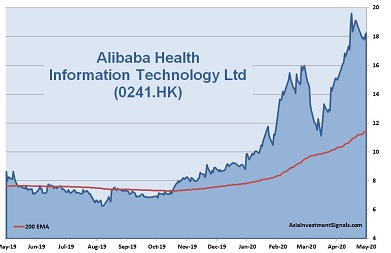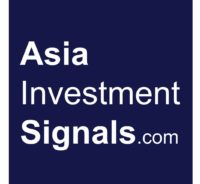 Alibaba Health Information Technology Ltd (0241.HK), also known as Ali Health, is a healthcare information and content service provider in China. The company is primarily engaged in the pharmaceutical self-operated business, the operations of a pharmaceutical e-commerce and consumer healthcare services platforms, the provision of tracking services, and other innovative health services in China.[mepr-active membership=”1734″ ifallowed=”show” unauth=”message” unauth_message=”Please login or purchase a membership to view full text.”]
Alibaba Health Information Technology Ltd (0241.HK), also known as Ali Health, is a healthcare information and content service provider in China. The company is primarily engaged in the pharmaceutical self-operated business, the operations of a pharmaceutical e-commerce and consumer healthcare services platforms, the provision of tracking services, and other innovative health services in China.[mepr-active membership=”1734″ ifallowed=”show” unauth=”message” unauth_message=”Please login or purchase a membership to view full text.”]
The pharmaceutical self-operated business is Ali Health’s most significant revenue contributor, accounting for 83 percent of the company’s revenue. The segment offers B2C services through its online stores on Tmall.com and its offline pharmacy outlets, as well as B2B services to merchant customers. The segment grew by 113 percent over the first half-year 2019/20. The pharmaceutical e-commerce business operates Tmall Pharmacy, China’s largest healthcare e-commerce platform. Tmall Pharmacy offers online health and adult products, healthcare services, as well as medical devices. The segment accounted for 13 percent of the revenue and grew by 140 percent over that period. The consumer healthcare segment contributed to only 3 percent of the revenue but grew by 274 percent over that period. Through its online stores on Tmall.com and mobile apps, Ali Health connects medical and healthcare service organizations to end customers.
Ali Health was founded in 1998 and is headquartered in Hong Kong. Ali Health was formerly known as CITIC 21CN before it changed the name in 2014. The company is listed on Hong Kong’s stock exchange. Its shares can also be traded in Germany, Switzerland, and the US. Major shareholder is Alibaba Group Holding, with ownership of around 69 percent. Directors and chief executives of the company hold about 0.24 percent only in the company. Roughly 25 percent of the shares are in public hands.
With a workforce of over 880 employees, Ali Health reported revenues of 4.1bn RMB (582m USD) and profits before tax of 5.6m RMB (0.8m USD) over the first half-year 2019/20. This is an increase of 119 and 107 percent respectively compared to the same period a year ago. For the full fiscal year 2018/19, revenues and profits increased by 109 and 36 percent, respectively. The operating margin (TTM) of -0.5 percent is well below the industry average. Ali Health’s cash reserves increased by 848 percent to 2.7bn RMB (376m USD), while debts and lease obligations decreased by 36 percent to 1.1bn RMB (153m USD) over the first half-year 2019/20.
The company shows a robust balance sheet with good financial strength, but still low profitability. The equity ratio is at 62 percent and the gearing, defined here as total liabilities to total equity, at 62 percent. Moody’s daily credit risk score for Ali Health is 4, indicating a medium risk, based on the day-to-day movements in market value compared to the company’s liability structure. Next earning results will be announced at the end of May.
Ali Health’s shares are in an uptrend since October 2019 and gained more than 150 percent in value since. Share price more than doubled alone this year. The company is currently priced at 40 times book value and at 26 times sales. Ali Health does not pay dividends. Almost all covering analysts have a ‘buy’ or ‘outperform’ recommendations on the stock.
Our conclusion: Ali Health shows a robust balance sheet with good financial strength, but still low profitability. The valuation is high but comes with a compounded annual growth rate for revenue and profits of over 300 and 50 percent respectively over the last three years. The outlook for the healthcare and related industries in China is positive as the demand for health management of China’s residents continues to grow, and health-related consumption expenditure continues to increase. Ali Health has considerable potential to continue its sustainable growth. The company is well-positioned in an intensely competitive environment. Given a stable business environment, we expect the share price to increase another 20 to 30 percent until the end of this year.
AIS Rating: ★★★★☆
| 2014/5 | 2015/6 | 2016/7 | 2017/8 | 2018/9 | 2019/20 H1 only |
|
|---|---|---|---|---|---|---|
| EPS (RMBcents) | (1.04) | (2.34) | (2.54) | (1.16) | (0.74) | (0.01) |
| Change (%) | (25) | (125) | (9) | 54 | 36 | 99 |
| DPS (RMBcents) | n/a | n/a | n/a | n/a | n/a | n/a |
| P/E | P/E INDUSTRY |
P/B | P/CF | Equity Ratio* |
ROE | LIAB./ Equity** |
Div YLD |
|---|---|---|---|---|---|---|---|
| n/a | 23 | 40 | 365 | 62% | 0.03% | 62% | n/a |
* Equity / Total Assets, ** Total Liabilities / Equity
[/mepr-active]
